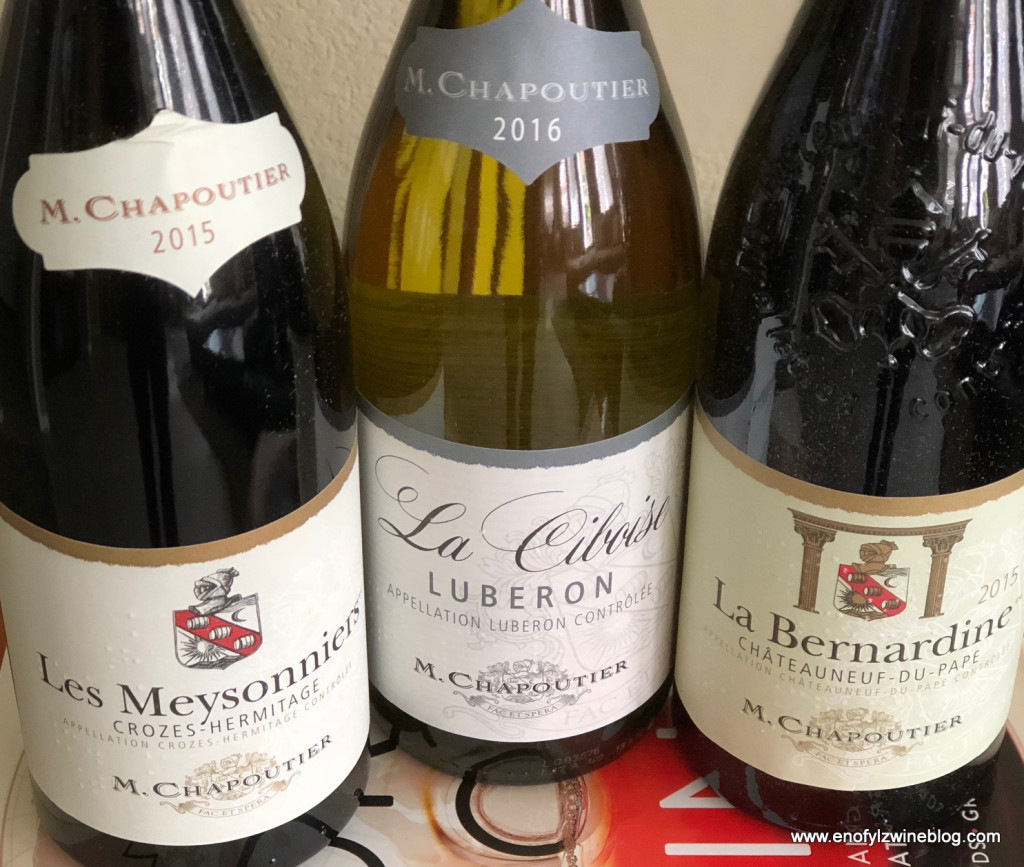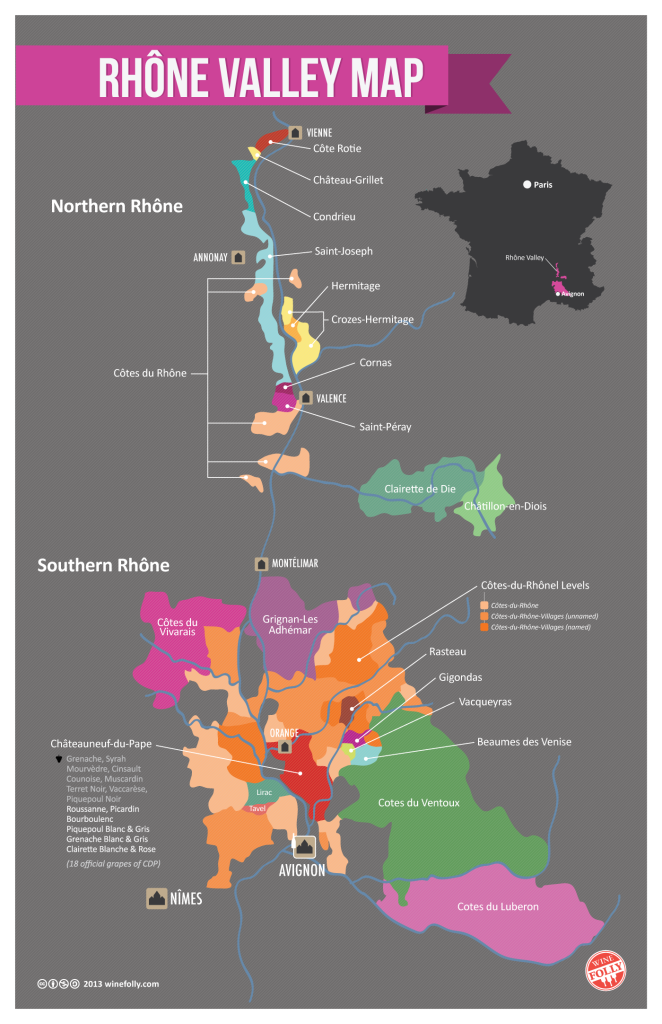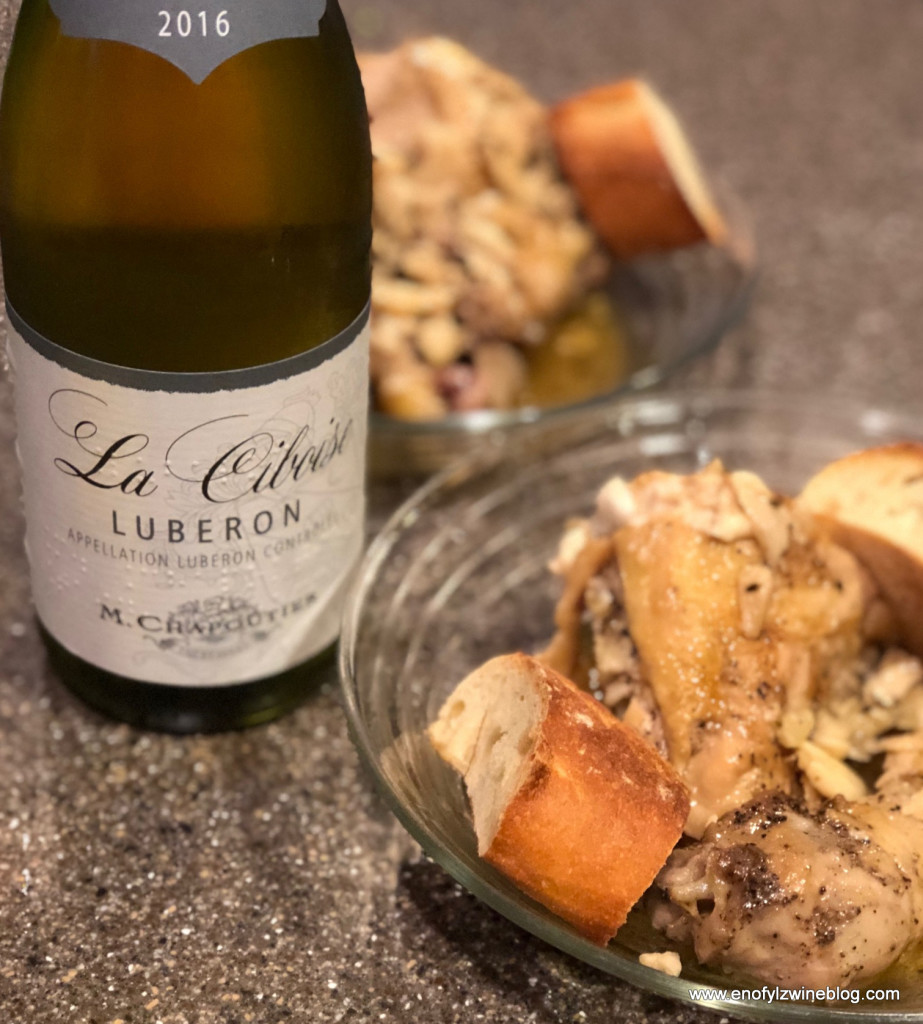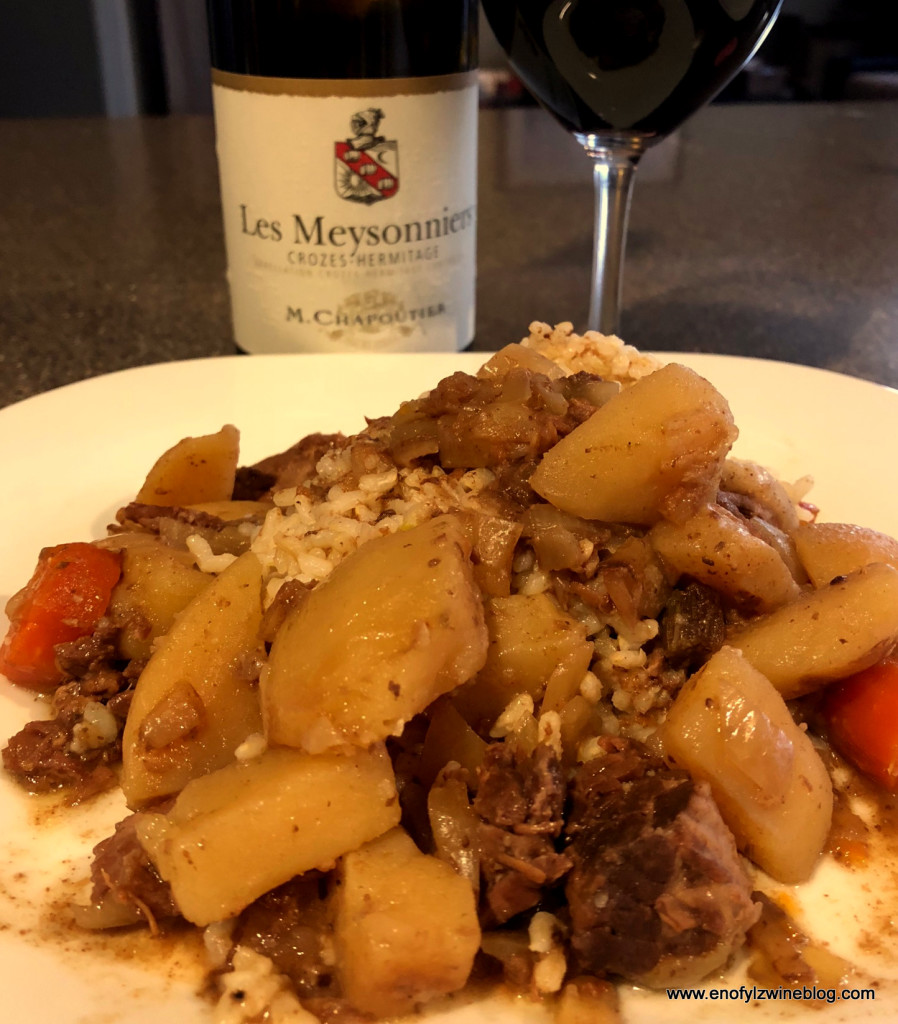This month the French Winophiles are roaming the Rhône Valley! We received three sample wines from the venerable House of Chapoutier from three different regions of the Rhône Valley – Crozes Hermitage, Chateauneuf-du-Pape and Luberon.

Overview of the Rhône Valley
The Rhône Valley is a key wine-producing region in the southeast of France. It follows the north–south course of the Rhône river for almost 150 miles from Lyon to the Rhône Delta , near the Mediterranean coast.
No name is more closely associated with the greatness of the Rhone valley than M. Chapoutier. – Terlato Wines
The length of the valley means that Rhône wines are the product of a wide variety of soil types and mesoclimates. The region’s wine-producing areas cover such a distance that it is divided into two parts, the northern Rhône and the southern Rhône . The distance between the northern and southern Rhône is about 25 miles. The wines from each are distinctly different.
The region is dominated by red wine, although whites and rosés are made throughout the region (with one exception, no rosés are made in the northern Rhone). The most famous northern Rhône reds are Cote-Rotie and Hermitage the most famous southern red is Chateauneuf-du-Pape.
Syrah is sole red grape in the north, while southern reds are usually a blend of many grapes, the most important of which are Grenache and Mourvedre. There are 27 permitted grapes in the Rhône.
The Northern Rhône has a continental climate and experiences greater seasonal temperature differences than the Southern Rhône. It is also more hilly landscape.
The climate of the Southern Rhône is Mediterranean; the landscape is much flatter. It accounts for about 95% of all wine produced in the Rhône Valley.

The Southern Rhône was the first quality region in France to be struck by phylloxera in 1863. During the decades of replanting following the epidemic, the growers of Châteauneuf-du-Pape introduced a set of rules for production. These rules became the prototype for the Appellation Contrôlée system, and in 1936 Châteauneuf-du-Pape became the first AOC in France
Below you’ll find more information about the three regions and the respective wines representing those regions. You’ll also find the foods I paired with each of the wines.
Luberon
Luberon (formerly Cotes du Luberon) is an appellation for wines made in the picturesque surroundings of the Luberon National Park in south-eastern France. It is geographically wedged between the Rhone and Provence. The region’s wine reflect a stylistic intersection of those two regions. The appellation was created in 1988, but the history of winemaking in Luberon dates back centuries.
It is a mountainous region where the vines grow at an altitude of between 200 and 450 metres. Syrah is the dominant variety of the appellation (used in its red and rosé wines) and is accompanied by Grenache, Mourvedre, Cinsaut and a maximum addition of 20% Carignan. The better Luberon wines are concentrated, full-bodied, herb-scented red wines which develop reasonably well with age.
Whites are made from Grenache Blanc, Clairette, Bourboulenc, Ugni Blanc, Vermentino and occasionally include Marsanne and Roussanne. Rosé wines made under the appellation may incorporate up to 20% of these white varieties.
The region’s Mediterranean climate brings the long, warm days so characteristic of the wider region, but Luberon has cooler nights than most Rhone wine-producing areas. This higher diurnal temperature variation helps to produce some of the crisper, more interesting white wines of the southern Rhone.

2016 M. Chapoutier Luberon Blanc La Ciboise – France, Rhône, Southern Rhône, Luberon
Color – Pale green with yellow highlights
Aromas – Lemon zest, white flowers, wet stone, yellow melon, white peach dried herb, and almonds
Body – Medium – bodied, focused and persistent with mouth-watering acidity.
Taste – White peach, lemon zest, pear and low-key spice flavors
Finish – Medium
88 pts. |Blend of Grenache Blanc,Vermentino, Ugni Blanc and Roussane|13% abv|SRP -$16|Sample
This was my first wine from Luberon. I was impressed with the value of this wine. I will definitely be on the lookout for more Luberon wines!
Paired with: A Chicken and Forty Cloves; A very good pairing! Also consider pairing with Seafood salads, Pan Bagnat or goat cheese!
Chateauneuf-du-Pape
Chateauneuf-du-Pape (“CDP’) is one of the France’s most historic and famous wine regions. It was name after “the Pope’s new house” when the Papacy relocated to Avignon in the fourteenth century and summer residences were constructed. It is famous for powerful, full-bodied red wines made predominantly from the classic southern Rhône grape trio: Grenache, Syrah and Mourvèdre (a.k.a. “GSM”) These three varieties are behind the vast majority of the appellation’s red wines, although a total of eighteen are approved for use – a mix of red and white grape varieties. The soils of Chateauneuf-du-Pape are pebbly and sandy, as is common in the southern half of the Rhône Valley. The archetypal Châteauneuf vineyard is strewn with large pebbles known as galets, or pudding stones that store heat and aid in the ripening of the grapes. Dry northern Mistral winds, which blow for at least 200 days a year play a prominent role in grape growing in the region. The mistral winds are a blessing. They are nature’s way to keep the grapes dry and healthy, without forcing growers to resort to much in the way of agricultural chemicals.
Fun fact: CDP was the first AOC to forbid the landing of flying saucers inside the commune boundaries

2015 M. Chapoutier Châteauneuf-du-Pape La Bernardine – France, Rhône, Southern Rhône, Châteauneuf-du-Pape
Color – Crimson red
Aromas – Black cherry, red currant, sandalwood, leather, espresso, and warm spice aromas
Body – Medium-bodied, harmonious, and fresh with juicy, supple tannins
Taste – Black cherry, red currant, black licorice, black cherry and warm spice flavors
Finish – Long
90 pts.|Blend of 90% Grenache and 10% Syrah|SRP – $60|Sample
Paired with: Grilled Garlic and Fennel Sausages and Roasted Hen of the Woods Mushrooms. An excellent pairing! Also consider pairing with hearty stews, grilled lamb, or Moroccan tagine!
Crozes-Hermitage
The Crozes-Hermitage appellation, created in 1937.. It is spread across 11 local authority areas in the Drôme on the left-bank of the Rhône, to the north, south, and east of Tain-l’Hermitage. It is much larger than the prestigious Hermitage appellation which it surrounds.
The vast majority (around 90 percent) of Crozes-Hermitage wines are red, and made predominantly from Syrah. The remaining 10 percent are white Crozes-Hermitage Blanc wines made from Roussanne and Marsanne.
If you’re looking for value in northern Rhône, Crozes-Hermitage is a great place to start!

2015 M. Chapoutier Crozes-Hermitage Les Meysonniers – France, Rhône, Northern Rhône, Crozes-Hermitage
Color – Brilliant garnet color
Aromas – Black currant, white pepper, olive tapenade, roasted meat, and black cherry with appealing earthy aromas
Body – Medium-bodied and harmonious with mouth-watering acidity and well-integrated suave tannins
Taste – Black currant, black cherry, blackberry and savory spice flavors
Finish – Medium long
90 pts.| 100% Syrah|13% abv|SRP -$44|Sample
Paired with: Slow Cooker Beef Stew; A very good pairing. Also consider pairing with Cassoulet, French Onion Soup, or dishes that incorporate braised meats.
My Takeaways
All three of these wines were fabulous and showcase the diversity and depth of the not only the Rhône Valley, but also the House of M. Chapoutier. If you’re looking for wine from the Rhône Valley, and you’re confronted with the infamous “wall of wine”, look for the Chapoutier label, you won’t regret it!
About M. Chapoutier
The history of the Chapoutier family stretches back to the early nineteenth century when current owner Michel Chapoutier’s great-, great-, great-grandfather Marius purchased an estate and some vineyards in the now famous village of Tain l’Hermitage in the Northern Rhône Valley. Marius Chapoutier made history in the region when he became the first grape grower there to vinify his own fruit. Marius had tasted wines other winemakers produced using his fruit and he realized that something was lost in translation, so to speak. He knew that he owned some of the best growing sites in the appellation and he believed — rightly — that the grapes grown in his vineyards could produce long-lived world-class wines. In a move unusual at the time, he decided that he should make the wine himself. Not only did the quality of the wines increase greatly, but this move provided the capital to expand the Chapoutiers’ already legendary estate.
Expansion, improved vineyard management, and modernization of the winery continued when Max Chapoutier took the reigns from his father Marius: over the last 200 years, the Chapoutier family has acquired what is arguably the most significant holding of vineyard sites in the region and as the interest in Rhône Valley wines grew, so did the house’s reputation for world-class, long-lived wines — white and red. In many respects, the family is an element essential to Rhône Valley winemaking: an entry for their family name has appeared in the Oxford Companion to Wine since its first printing (1994) where it is called one of the region’s “great names.” Today, the famed M. Chapoutier sign in their signature vineyard on Hermitage hill is one of the region’s most recognizable icons.
Since he took over the estate in 1990, Michel — a wine icon in his own right — has revolutionized his family’s winery and the Rhône Valley wine industry. Innovations introduced by him have included: 100% biodynamic viticulture, aggressive vineyard management, vintage dating for all the estate’s wines, and the elimination of fining and filtration.

“Come to Tain l’Hermitage,” says Michel with well-merited pride, “and you will see our connection to the vineyards: our winery and our homes are surrounded by the vineyards where we grow our grapes. When I walk outside my door, I find myself in the middle of our vines.”
The winery’s proximity to the vineyards is an essential element to the M. Chapoutier approach to winemaking: not only does this mean that the fruit is not stressed by unnecessary transport (the winery is literally a stone’s throw from the estate’s vineyards), says Michel, but “we live within our terroir. This is why our wines are a true expression of where they are made.”
M. Chapoutier wines are widely considered to be among the top offerings from the Rhône Valley. Because of their remarkable longevity, they are also highly coveted among the world’s leading collectors. Today, M. Chapoutier continues to further its legacy as a benchmark for the industry in general: the biodynamic model created by Michel in the 1990s has become the standard by which the entire biodynamic industry is measured in contemporary Europe. Most thought twenty-six-year-old Michel daring when he converted his family’s legendary estate to new methods of growing and winemaking. Today, his peers continue to view him as an innovator, leader, forward-thinker, and risk-taker who changed the course of French winemaking for the better. (Source – Terlato Wines)
Fun fact: Since 1996 all M. Chapoutier labels have included braille in honor of Maurice Monier de la Sizeranne, who created a modern form of abbreviated braille, and who was the original owner of the Chapoutier vineyard in Hermitage.
Check out these other posts from The French #Winophiles on the wines of the Rhône Valley and Michel Chapoutier, and join us Saturday morning, March 17 at 8 a.m. PST on Twitter. Just use #Winophiles – it’s really fun!
- Gwendolyn Alley at Wine Predator tells us about “Duck à l’Orange with M. Chapoutier’s Biodynamic, Organic Rhone Wines”
- Jill Barth from L’Occasion writes about “Braille on the Label and Other Pioneering Moments of Chapoutier”
- J.R. Boynton from Great Big Reds writes about “The Dark Side of Syrah, with Domaine Fondreche Persia 2012 (Ventoux)”
- Jeff Burrows from Food Wine Click shares “Northern Rhone Wines and My Steak Tartare Disaster”
- David Crowley at Cooking Chat at tells us about “London Broil Steak with Châteauneuf-du-Pape”
- Rob Frisch at Odd Bacchus writes about “Return to the Rhône”
- Susannah Gold at Avvinare writes about “Rhône Gems from Chapoutier in Chateauneuf, du Pape, Crozes-Hermitage, and Luberon”
- Nicole Ruiz Hudson at Somm’s Table tells her story of “Cooking to the Wine: Les Vins de Vienne Gigondas with Gratinéed Shepherd’s Pie”
- Camilla Mann from Culinary Adventures with Camilla shares a post on “Sober Clams + a French Syrah”
- Jane Niemeyer at Always Ravenous shares “Bison Burger Paired with Northern Rhône Syrah”
- Rupal Desai Shankar at Syrah Queen writes about “Chapoutier: King of the Rhône”
- Lauren Walsh at The Swirling Dervish writes about “France’s Rhône Valley: Mountains, Sea, Wind, and Wine”
- Michelle Williams at Rockin Red Blog writes about “Maison M. Chapoutier: Expressing Terroir Through Biodynamics”
- Wendy Klik at A Day in the Life on the Farm talks about when “Ireland and France Collide“
- Liz at What’s in that Bottle invites us to “Get to know the Rhone Valley with Michel Chapoutier“
________________________________________________________________________
Follow me on Twitter, Facebook, Instagram, Vivino and Delectable, for all things wine. As a wino with latent foodie tendencies, you’ll also find food and wine pairings, and food related stuff! Become a fan and join ENOFYLZ Wine Blog on Facebook. Cheers!
Copyright Notice: This entire site is Copyrighted 2010-2018. All Rights Reserved. No unauthorized copying of any section of this site is permitted. If you wish to use any part of this site, contact me. For information on Copyright Law, see the official U.S. Copyright Office home page.
Those food pairings all sound spot-on and thoroughly delicious to me! I especially love the Crozes-Hermitage/cassoulet pairing idea — that sounds sensational. And I bet the Luberon Blanc was great with that chicken. I liked it much better with food, and that pairing sounds ideal.
Your Chateauneuf-du-Pape pairing looks absolutely delicious. I’ll give it a try!
Infamous wall of wine! So funny and so true. Thanks for posting. Chicken with 40 cloves?!? Now we’re talking. Cheers, Martin.
So pleased that all of your pairings turned out so well. This really was like hitting the Rhone wine jackpot.
Nice article Martin- I’ll bet the sausage and mushrooms were indeed fabulous with that CdP! And I appreciate your “Takeaways”.
Thanks for all the in-depth information on Rhone and Chapoutier. Your pairings look delicious, as always!
Funny how much grief Chapoutier gets because their entry level stuff floods the supermarkets. Quality wines at every price point, what’s not to like?
All of these pairings look fantastic, but I particularly intrigued by the 40 cloves and the Luberon Blanc. Love Chapoutier–I sure these were all fantastic!
A host of great pairings, Martin! I really like the sausage and mushroom idea, as my husband loves that combination. When he’s in need of comfort food, that’s usually what I make. Now I’ve got another option. Cheers!
Yes! That 40 cloves looks indispensable – what a dish.
You’ve nailed these pairings and I’m bookmarking the ideas. We love drinking Rhône cru wines and these meals will be fun to serve.
Nice post Martin!
I’ve never heard of chicken with 40 cloves — will have to try it sometime as my husband does chicken and I loves cloves!
Great information on the Rhône Valley and M.Chapoutier. Your food pairings look amazing, did you have a favorite?
Great post, Martin! Your CDP pairing – the sausages and mushrooms – has my mouth watering. I also LOVE the fun fact about no flying saucers landing in the CDP AOC!
Great article. I love your in depth review of the three Rhone villages. Great pairings too…
Thanks Rupal! I appreciate the kind words!
Definitely solid advice to grab a Chapoutier when looking for a Rhone wine! I like the sound of the chicken with 40 cloves!
Thanks David! If you’ve not had 40 cloves and a chicken, I recommend giving it a try!